| Common name | Scientific name and subspecies | Range | Size and ecology | IUCN status and estimated population |
|---|
| Acuminate horseshoe bat  | R. acuminatus
Peters, 1871 | Southeastern Asia
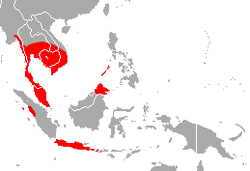 | Size: 4–6 cm (2 in), plus 1–4 cm (0.4–1.6 in) tail
4–6 cm (2 in) forearm length [4]
Habitat: Forest and caves [5] | LC
Unknown  [5] [5]
|
|---|
| Adam's horseshoe bat | R. adami
Aellen & Brosset, 1968 | Republic of the Congo
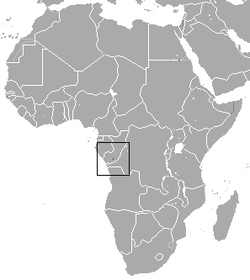 | Size: Unknown length, plus 2–3 cm (1 in) tail
4–6 cm (2 in) forearm length [6]
Habitat: Forest and caves [7] | DD
Unknown  [7] [7]
|
|---|
| Andaman horseshoe bat | R. cognatus
K. Andersen, 1906 | Andaman Islands
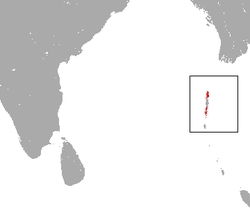 | Size: About 4 cm (2 in), plus 1–3 cm (0.4–1.2 in) tail
3–5 cm (1–2 in) forearm length [4]
Habitat: Forest and caves [8] | EN
Unknown  [8] [8]
|
|---|
| Arcuate horseshoe bat  | R. arcuatus
Peters, 1871
- R. a. arcuatus
- R. a. exiguus
| Southeastern Asia
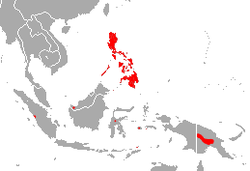 | Size: 4–7 cm (2–3 in), plus 1–3 cm (0.4–1.2 in) tail
4–6 cm (2 in) forearm length [9]
Habitat: Forest and caves [10] | DD
Unknown  [10] [10]
|
|---|
| Beddome's horseshoe bat 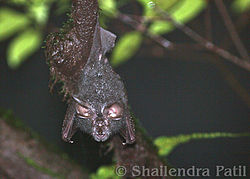 | R. beddomei
K. Andersen, 1905 | Southern India and Sri Lanka
 | Size: 6–8 cm (2–3 in), plus 3–5 cm (1–2 in) tail
5–7 cm (2–3 in) forearm length [11]
Habitat: Forest and caves [12] | LC
Unknown  [12] [12]
|
|---|
| Big-eared horseshoe bat | R. macrotis
Blyth, 1844
- R. m. caldwelli
- R. m. episcopus
- R. m. huananus
- R. m. macrotis
- R. m. topali
| Eastern and southeastern Asia
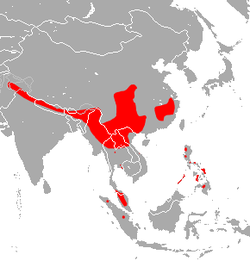 | Size: 4–6 cm (2 in), plus 1–4 cm (0.4–1.6 in) tail
4–6 cm (2 in) forearm length [13]
Habitat: Forest and caves [14] | LC
Unknown  [14] [14]
|
|---|
| Blasius's horseshoe bat 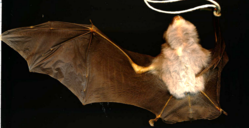 | R. blasii
Peters, 1866 | Scattered Africa, southern Europe, and western Asia
 | Size: 4–6 cm (2 in), plus 2–4 cm (1–2 in) tail
4–6 cm (2 in) forearm length [6]
Habitat: Forest, savanna, shrubland, caves, and desert [15] | LC
Unknown  [15] [15]
|
|---|
| Blyth's horseshoe bat  | R. lepidus
Blyth, 1844
- R. l. lepidus
- R. l. refulgens
| Southern and southeastern Asia
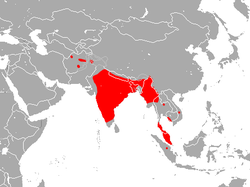 | Size: 3–6 cm (1–2 in), plus 1–3 cm (0.4–1.2 in) tail
3–5 cm (1–2 in) forearm length [4]
Habitat: Forest and caves [16] | LC
Unknown  [16] [16]
|
|---|
| Bokhara horseshoe bat  | R. bocharicus
Kastschenko & Akimov, 1917 | Central Asia
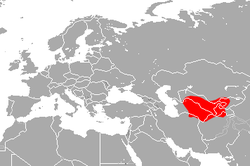 | Size: 3–5 cm (1–2 in), plus 2–4 cm (1–2 in) tail
4–6 cm (2 in) forearm length [13]
Habitat: Shrubland, grassland, rocky areas, caves, and desert [17] | LC
Unknown  [17] [17]
|
|---|
| Bornean horseshoe bat 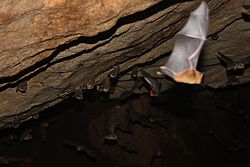 | R. borneensis
Peters, 1861 | Southeastern Asia
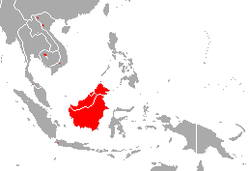 | Size: Unknown length, plus 2–3 cm (1 in) tail
4–6 cm (2 in) forearm length [4]
Habitat: Forest, rocky areas, and caves [18] | LC
Unknown  [18] [18]
|
|---|
| Bornean woolly horseshoe bat | R. proconsulis
Hill, 1959 | Borneo | Size: Unknown length
4–6 cm (2 in) forearm length [9]
Habitat: Forest [19] | EN
Unknown  [19] [19]
|
|---|
| Bourret's horseshoe bat | R. paradoxolophus
Bourret, 1951 | Southeastern Asia
 | Size: 4–6 cm (2 in), plus 1–4 cm (0.4–1.6 in) tail
5–7 cm (2–3 in) forearm length [13]
Habitat: Forest and caves [20] | LC
Unknown  [20] [20]
|
|---|
| Broad-eared horseshoe bat  | R. euryotis
Temminck, 1835 | Southeastern Asia
 | Size: 5–8 cm (2–3 in), plus 1–3 cm (0.4–1.2 in) tail
4–6 cm (2 in) forearm length [9]
Habitat: Caves and forest [21] | LC
Unknown  [21] [21]
|
|---|
| Bushveld horseshoe bat | R. simulator
K. Andersen, 1904 | Eastern and western Africa
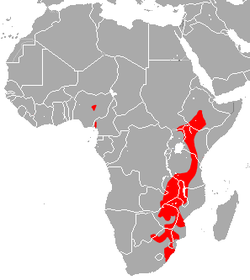 | Size: 3–7 cm (1–3 in), plus 1–3 cm (0.4–1.2 in) tail
3–5 cm (1–2 in) forearm length [6]
Habitat: Savanna and caves [22] | LC
Unknown  [22] [22]
|
|---|
| Canut's horseshoe bat  | R. canuti
Thomas & Wroughton, 1909 | Indonesia
 | Size: 5–7 cm (2–3 in), plus 1–3 cm (0.4–1.2 in) tail
4–6 cm (2 in) forearm length [4]
Habitat: Forest and caves [23] | VU
7,500–10,000  [23] [23]
|
|---|
| Cape horseshoe bat 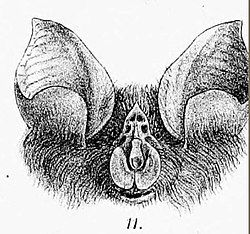 | R. capensis
Lichtenstein, 1823 | Southern Africa
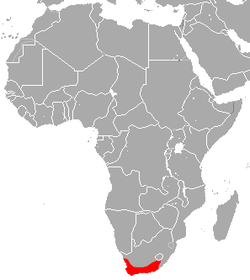 | Size: 5–7 cm (2–3 in), plus 2–4 cm (1–2 in) tail
4–6 cm (2 in) forearm length [6]
Habitat: Shrubland and caves [24] | LC
Unknown  [24] [24]
|
|---|
| Chiewkwee's horseshoe bat | R. chiewkweeae
Yoshiyuki & Liat, 2005 | Southeastern Asia | Size: 5–7 cm (2–3 in), plus 1–2 cm (0.4–0.8 in) tail
4–6 cm (2 in) forearm length [11]
Habitat: Forest [25] | DD
Unknown  [25] [25]
|
|---|
| Chinese rufous horseshoe bat  | R. sinicus
K. Andersen, 1905 | Eastern Asia
 | Size: 4–6 cm (2 in), plus 2–3 cm (1 in) tail
4–6 cm (2 in) forearm length [9]
Habitat: Forest and caves [26] | LC
Unknown  [26] [26]
|
|---|
| Cohen's horseshoe bat | R. cohenae
Taylor, Stoffberg, Monadjem, Schoeman, Bayliss, & Cotterill, 2012 | South Africa | Size: 7–9 cm (3–4 in), plus 3–5 cm (1–2 in) tail
6–7 cm (2–3 in) forearm length [6]
Habitat: Savanna, grassland, rocky areas, and caves [27] | VU
900–1,000  [27] [27]
|
|---|
| Convex horseshoe bat | R. convexus
Csorba, 1997 | Southeastern Asia
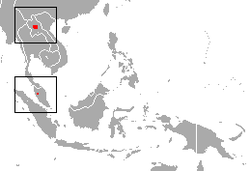 | Size: Unknown length, plus 1–3 cm (0.4–1.2 in) tail
4–6 cm (2 in) forearm length [4]
Habitat: Forest [28] | DD
Unknown  [28] [28]
|
|---|
| Creagh's horseshoe bat  | R. creaghi
Thomas, 1896 | Southeastern Asia
 | Size: About 5 cm (2 in), plus 1–2 cm (0.4–0.8 in) tail
4–6 cm (2 in) forearm length [4]
Habitat: Forest and caves [29] | LC
Unknown  [29] [29]
|
|---|
| Croslet horseshoe bat | R. coelophyllus
Peters, 1867 | Southeastern Asia
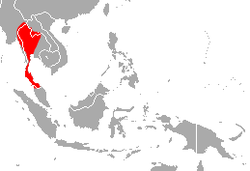 | Size: 3–5 cm (1–2 in), plus 1–3 cm (0.4–1.2 in) tail
4–6 cm (2 in) forearm length [9]
Habitat: Forest and caves [30] | LC
Unknown  [30] [30]
|
|---|
| Damara horseshoe bat | R. damarensis
Roberts, 1946 | Southern Africa | Size: 6–7 cm (2–3 in), plus 2–4 cm (1–2 in) tail
4–6 cm (2 in) forearm length [6]
Habitat: Savanna, shrubland, and desert [31] | LC
20,000  [31] [31]
|
|---|
| Darling's horseshoe bat | R. darlingi
K. Andersen, 1905 | Southern Africa
 | Size: 5–7 cm (2–3 in), plus 2–4 cm (1–2 in) tail
4–6 cm (2 in) forearm length [6]
Habitat: Savanna and caves [32] | LC
Unknown  [32] [32]
|
|---|
| Decken's horseshoe bat  | R. deckenii
Peters, 1867 | Eastern Africa
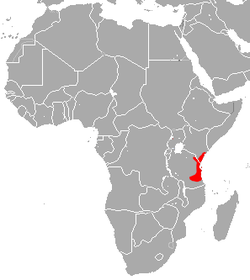 | Size: 5–7 cm (2–3 in), plus 2–4 cm (1–2 in) tail
4–6 cm (2 in) forearm length [6]
Habitat: Forest and caves [33] | NT
Unknown  [33] [33]
|
|---|
| Dent's horseshoe bat | R. denti
Thomas, 1904 | Southern and western Africa
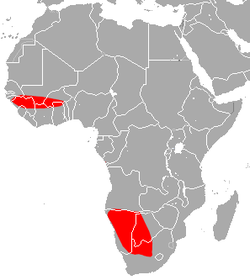 | Size: 4–6 cm (2 in), plus 1–3 cm (0.4–1.2 in) tail
3–5 cm (1–2 in) forearm length [6]
Habitat: Savanna and caves [34] | LC
Unknown  [34] [34]
|
|---|
| Dobson's horseshoe bat | R. yunanensis
Dobson, 1872 | Southeastern Asia
 | Size: 5–8 cm (2–3 in), plus 1–3 cm (0.4–1.2 in) tail
4–6 cm (2 in) forearm length [11]
Habitat: Forest and caves [35] | LC
Unknown  [35] [35]
|
|---|
| Eloquent horseshoe bat 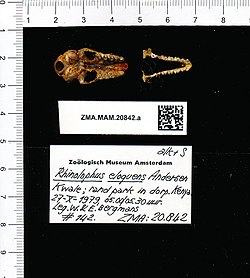 | R. eloquens
K. Andersen, 1905 | Eastern Africa
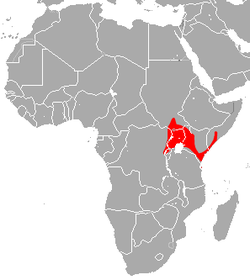 | Size: 6–8 cm (2–3 in), plus 2–5 cm (1–2 in) tail
5–7 cm (2–3 in) forearm length [6]
Habitat: Forest, savanna, and caves [36] | LC
Unknown  [36] [36]
|
|---|
| Forest horseshoe bat | R. silvestris
Aellen, 1959 | West-central Africa
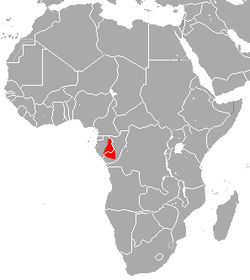 | Size: Unknown length, plus 2–4 cm (1–2 in) tail
4–6 cm (2 in) forearm length [13]
Habitat: Forest and caves [37] | DD
Unknown  [37] [37]
|
|---|
| Formosan lesser horseshoe bat  | R. monoceros
Temminck, 1835 | Japan and China | Size: 4–6 cm (2 in), plus 1–3 cm (0.4–1.2 in) tail
3–4 cm (1–2 in) forearm length [4]
Habitat: Unrecorded | NE
Unknown 
|
|---|
| Formosan woolly horseshoe bat 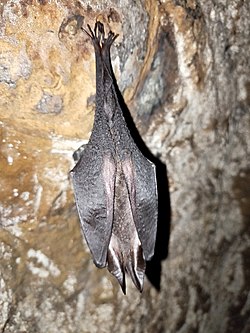 | R. formosae
Sanborn, 1939 | Taiwan
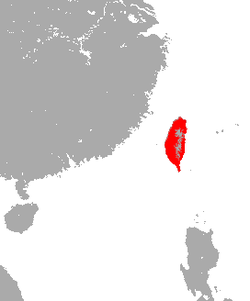 | Size: 6–9 cm (2–4 in), plus 2–5 cm (1–2 in) tail
5–7 cm (2–3 in) forearm length [11]
Habitat: Forest and caves [38] | LC
Unknown  [38] [38]
|
|---|
| Geoffroy's horseshoe bat  | R. clivosus
Cretzschmar, 1828
- R. c. brachygnathus
- R. c. clivosus
| Africa and Arabian Peninsula
 | Size: 4–6 cm (2 in), plus 2–4 cm (1–2 in) tail
4–6 cm (2 in) forearm length [13]
Habitat: Forest, savanna, shrubland, caves, and desert [39] | LC
Unknown  [39] [39]
|
|---|
| Great woolly horseshoe bat  | R. luctus
Temminck, 1834 | Southern and southeastern Asia
 | Size: 7–9 cm (3–4 in), plus 3–6 cm (1–2 in) tail
5–8 cm (2–3 in) forearm length [11]
Habitat: Caves, rocky areas, and forest [40] | LC
Unknown  [40] [40]
|
|---|
| Greater horseshoe bat 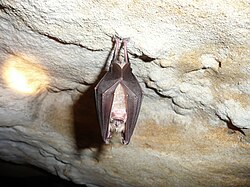 | R. ferrumequinum
(Schreber, 1774)
- R. f. creticum
- R. f. ferrumequinum
- R. f. irani
- R. f. korai
- R. f. nippon
- R. f. proximus
- R. f. tragatus
| Europe, Asia, and northern Africa
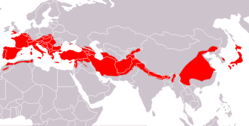 | Size: 5–8 cm (2–3 in), plus 3–5 cm (1–2 in) tail
5–7 cm (2–3 in) forearm length [13]
Habitat: Forest, shrubland, grassland, and caves [41] | LC
Unknown  [41] [41]
|
|---|
| Guinean horseshoe bat | R. guineensis
Eisentraut, 1960 | Western Africa
 | Size: 4–6 cm (2 in), plus 2–3 cm (1 in) tail
4–6 cm (2 in) forearm length [6]
Habitat: Forest, savanna, grassland, inland wetlands, and caves [42] | EN
Unknown  [42] [42]
|
|---|
| Halcyon horseshoe bat | R. alcyone
Temminck, 1852 | Western and central Africa
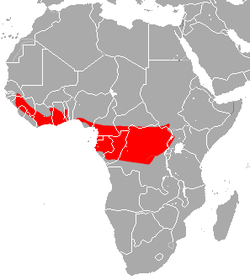 | Size: 5–7 cm (2–3 in), plus 1–4 cm (0.4–1.6 in) tail
4–6 cm (2 in) forearm length [6]
Habitat: Forest, savanna, and caves [43] | LC
Unknown  [43] [43]
|
|---|
| Hildebrandt's horseshoe bat | R. hildebrandtii
Peters, 1878 | Eastern Africa
 | Size: 7–9 cm (3–4 in), plus 3–5 cm (1–2 in) tail
6–7 cm (2–3 in) forearm length [6]
Habitat: Forest, savanna, and caves [44] | LC
Unknown  [44] [44]
|
|---|
| Hill's horseshoe bat | R. hilli
Aellen, 1973 | Rwanda
 | Size: About 6 cm (2 in), plus about 3 cm (1 in) tail
about 5 cm (2 in) forearm length [13]
Habitat: Forest and caves [45] | EN
Unknown  [45] [45]
|
|---|
| Hills' horseshoe bat | R. hillorum
Koopman, 1989 | Scattered Equatorial Africa
 | Size: 6–8 cm (2–3 in), plus 3–5 cm (1–2 in) tail
4–6 cm (2 in) forearm length [13]
Habitat: Forest, grassland, and caves [46] | VU
Unknown  [46] [46]
|
|---|
| Imaizumi's horseshoe bat | R. imaizumii
Hill & Yoshiyuki, 1980 | Japan | Size: 3–5 cm (1–2 in), plus 1–3 cm (0.4–1.2 in) tail
4–6 cm (2 in) forearm length [4]
Habitat: Unrecorded | NE
Unknown 
|
|---|
| Indo-Chinese lesser brown horseshoe bat | R. microglobosus
Csorba and Jenkins, 1998 | Southeastern Asia
 | Size: 3–6 cm (1–2 in), plus 1–3 cm (0.4–1.2 in) tail
4–6 cm (2 in) forearm length [9]
Habitat: Caves and forest [47] | LC
Unknown  [47] [47]
|
|---|
| Insular horseshoe bat  | R. keyensis
Peters, 1871 | Indonesia
 | Size: 3–5 cm (1–2 in), plus 1–3 cm (0.4–1.2 in) tail
3–5 cm (1–2 in) forearm length [4]
Habitat: Unknown [48] | DD
Unknown  [48] [48]
|
|---|
| Intermediate horseshoe bat  | R. affinis
Horsfield, 1823
- R. a. affinis
- R. a. andamanensis
- R. a. hainanus
- R. a. himalayanus
- R. a. macrurus
- R. a. nesites
- R. a. princes
- R. a. superans
- R. a. tener
| Southeastern Asia
 | Size: 4–7 cm (2–3 in), plus 1–4 cm (0.4–1.6 in) tail
4–6 cm (2 in) forearm length [9]
Habitat: Forest and caves [49] | LC
Unknown  [49] [49]
|
|---|
| King horseshoe bat | R. rex
Allen, 1923 | Eastern China
 | Size: 4–6 cm (2 in), plus 1–4 cm (0.4–1.6 in) tail
5–7 cm (2–3 in) forearm length [13]
Habitat: Forest and caves [50] | EN
1,500–2,000  [50] [50]
|
|---|
| Lander's horseshoe bat  | R. landeri
Martin, 1837 | Sub-Saharan Africa
 | Size: 4–6 cm (2 in), plus about 3 cm (1 in) tail
3–5 cm (1–2 in) forearm length [6]
Habitat: Forest, savanna, shrubland, and caves [51] | LC
Unknown  [51] [51]
|
|---|
| Large rufous horseshoe bat | R. rufus
Eydoux & Gervais, 1836 | Philippines
 | Size: 8–10 cm (3–4 in), plus 3–4 cm (1–2 in) tail
6–8 cm (2–3 in) forearm length [9]
Habitat: Forest and caves [52] | NT
Unknown  [52] [52]
|
|---|
| Large-eared horseshoe bat  | R. philippinensis
Waterhouse, 1843 | Southeastern Asia and northeastern Australia
 | Size: 5–7 cm (2–3 in), plus 2–4 cm (1–2 in) tail
4–6 cm (2 in) forearm length [13]
Habitat: Caves and forest [53] | LC
Unknown  [53] [53]
|
|---|
| Least horseshoe bat  | R. pusillus
Temminck, 1834 | Eastern and southeastern Asia
 | Size: 3–5 cm (1–2 in), plus 1–3 cm (0.4–1.2 in) tail
3–5 cm (1–2 in) forearm length [4]
Habitat: Forest and caves [54] | LC
Unknown  [54] [54]
|
|---|
| Lesser brown horseshoe bat  | R. stheno
K. Andersen, 1905 | Southeastern Asia
 | Size: 4–6 cm (2 in), plus 1–3 cm (0.4–1.2 in) tail
4–6 cm (2 in) forearm length [9]
Habitat: Forest [55] | LC
Unknown  [55] [55]
|
|---|
| Lesser horseshoe bat 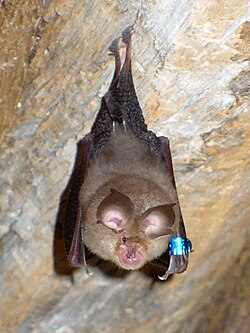 | R. hipposideros
(Bechstein, 1800) | Europe, western Asia, and northern Africa
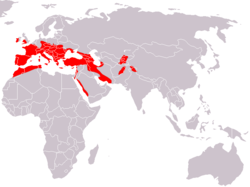 | Size: 3–5 cm (1–2 in), plus 2–4 cm (1–2 in) tail
3–5 cm (1–2 in) forearm length [9]
Habitat: Forest, shrubland, grassland, and caves [56] | LC
Unknown  [56] [56]
|
|---|
| Lesser woolly horseshoe bat 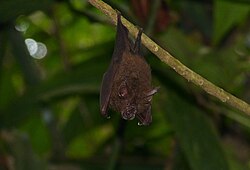 | R. sedulus
K. Andersen, 1905 | Southeastern Asia
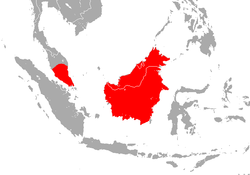 | Size: 4–6 cm (2 in), plus 1–3 cm (0.4–1.2 in) tail
3–5 cm (1–2 in) forearm length [9]
Habitat: Forest and caves [57] | NT
Unknown  [57] [57]
|
|---|
| Little Japanese horseshoe bat  | R. cornutus
Temminck, 1834
- R. c. cornutus
- R. c. orii
- R. c. pumilus
| Japan and China | Size: 3–6 cm (1–2 in), plus 1–3 cm (0.4–1.2 in) tail
3–5 cm (1–2 in) forearm length [4]
Habitat: Forest [58] | NT
Unknown  [58] [58]
|
|---|
| Little Nepalese horseshoe bat | R. subbadius
Blyth, 1844 | Eastern Asia
 | Size: 3–4 cm (1–2 in), plus 1–2 cm (0.4–0.8 in) tail
3–4 cm (1–2 in) forearm length [4]
Habitat: Forest and caves [59] | LC
Unknown  [59] [59]
|
|---|
| Maclaud's horseshoe bat | R. maclaudi
Pousargues, 1897 | Western Africa
 | Size: 7–10 cm (3–4 in), plus 3–5 cm (1–2 in) tail
6–7 cm (2–3 in) forearm length [13]
Habitat: Savanna and caves [60] | EN
Unknown  [60] [60]
|
|---|
| Madura horseshoe bat | R. madurensis
K. Andersen, 1918 | Indonesia
 | Size: Unknown length
3–5 cm (1–2 in) forearm length [4]
Habitat: Forest and caves [61] | VU
Unknown  [61] [61]
|
|---|
| Maendeleo horseshoe bat | R. maendeleo
Kock, Csorba, & Howell, 2000 | Eastern Africa
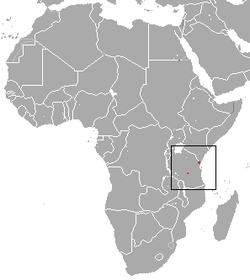 | Size: 4–6 cm (2 in), plus 2–3 cm (1 in) tail
4–6 cm (2 in) forearm length [6]
Habitat: Forest and caves [62] | DD
Unknown  [62] [62]
|
|---|
| Malayan horseshoe bat | R. malayanus
Bonhote, 1903 | Southeastern Asia
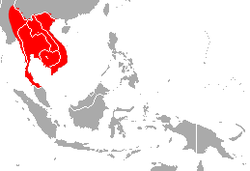 | Size: 3–5 cm (1–2 in), plus 1–3 cm (0.4–1.2 in) tail
3–5 cm (1–2 in) forearm length [4]
Habitat: Forest and caves [63] | LC
Unknown  [63] [63]
|
|---|
| Marshall's horseshoe bat | R. marshalli
Thonglongya, 1973 | Southeastern Asia
 | Size: 4–6 cm (2 in), plus 1–3 cm (0.4–1.2 in) tail
3–5 cm (1–2 in) forearm length [13]
Habitat: Forest, rocky areas, and caves [64] | LC
Unknown  [64] [64]
|
|---|
| McIntyre's horseshoe bat | R. mcintyrei
Hill & Schlitter, 1982 | Papua New Guinea | Size: 4–7 cm (2–3 in), plus 1–3 cm (0.4–1.2 in) tail
4–6 cm (2 in) forearm length [9]
Habitat: Forest [65] | DD
Unknown  [65] [65]
|
|---|
| Mediterranean horseshoe bat 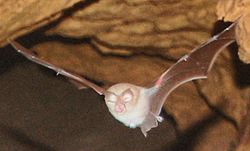 | R. euryale
Blasius, 1853 | Europe, western Asia, and northern Africa
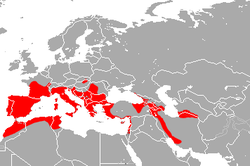 | Size: 4–6 cm (2 in), plus 2–3 cm (1 in) tail
4–6 cm (2 in) forearm length [6]
Habitat: Forest, shrubland, and caves [66] | NT
Unknown  [66] [66]
|
|---|
| Mehely's horseshoe bat  | R. mehelyi
Matschie, 1901 | Southern Europe, western Asia, and northern Africa
 | Size: 4–7 cm (2–3 in), plus 2–4 cm (1–2 in) tail
2–4 cm (1–2 in) forearm length [6]
Habitat: Shrubland and caves [67] | VU
Unknown  [67] [67]
|
|---|
| Mitred horseshoe bat  | R. mitratus
Blyth, 1844 | Eastern India
 | Size: About 7 cm (3 in), plus about 3 cm (1 in) tail
about 6 cm (2 in) forearm length [11]
Habitat: Unknown [68] | DD
Unknown  [68] [68]
|
|---|
| Mount Mabu horseshoe bat | R. mabuensis
Taylor, Stoffberg, Monadjem, Schoeman, Bayliss, & Cotterill, 2012 | Mozambique | Size: 7–9 cm (3–4 in), plus 3–5 cm (1–2 in) tail
6–7 cm (2–3 in) forearm length [6]
Habitat: Caves and forest [69] | EN
Unknown  [69] [69]
|
|---|
| Mozambican horseshoe bat  | R. mossambicus
Taylor, Stoffberg, Monadjem, Schoeman, Bayliss, & Cotterill, 2012 | Southeastern Africa | Size: Unknown length
6–7 cm (2–3 in) forearm length [6]
Habitat: Forest, savanna, and caves [70] | LC
Unknown  [70] [70]
|
|---|
| Neriad horseshoe bat | R. nereis
K. Andersen, 1905 | Siantan Island in Indonesia
 | Size: Unknown length, plus about 2 cm (1 in) tail
about 4 cm (2 in) forearm length [4]
Habitat: Unknown [71] | DD
Unknown  [71] [71]
|
|---|
| Osgood's horseshoe bat | R. osgoodi
Sanborn, 1939 | Southern China
 | Size: Unknown length, plus 1–3 cm (0.4–1.2 in) tail
4–6 cm (2 in) forearm length [13]
Habitat: Caves [72] | LC
Unknown  [72] [72]
|
|---|
| Pearson's horseshoe bat 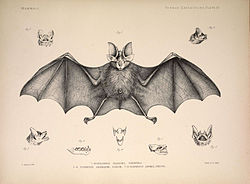 | R. pearsonii
Horsfield, 1851 | Eastern and southeastern Asia
 | Size: 5–7 cm (2–3 in), plus 1–3 cm (0.4–1.2 in) tail
4–6 cm (2 in) forearm length [11]
Habitat: Forest and caves [73] | LC
Unknown  [73] [73]
|
|---|
| Peninsular horseshoe bat | R. robinsoni
K. Andersen, 1918 | Malaysia and Thailand
 | Size: 4–6 cm (2 in), plus 1–3 cm (0.4–1.2 in) tail
4–6 cm (2 in) forearm length [4]
Habitat: Rocky areas and forest [74] | NT
Unknown  [74] [74]
|
|---|
| Philippine forest horseshoe bat | R. inops
K. Andersen, 1905 | Philippines
 | Size: 5–7 cm (2–3 in), plus 1–3 cm (0.4–1.2 in) tail
4–6 cm (2 in) forearm length [9]
Habitat: Forest [75] | LC
Unknown  [75] [75]
|
|---|
| Poso horseshoe bat | R. belligerator
Patrick, McCulloch, & Ruedas, 2013 | Sulawesi Island in Indonesia | Size: 5–7 cm (2–3 in), plus 1–3 cm (0.4–1.2 in) tail
4–6 cm (2 in) forearm length [9]
Habitat: Unknown [76] | EN
Unknown  [76] [76]
|
|---|
| Rufous horseshoe bat  | R. rouxii
Temminck, 1835 | Southern Asia
 | Size: 4–6 cm (2 in), plus 2–4 cm (1–2 in) tail
4–6 cm (2 in) forearm length [9]
Habitat: Forest and caves [77] | LC
Unknown  [77] [77]
|
|---|
| Ruwenzori horseshoe bat | R. ruwenzorii
Hill, 1942 | Central Africa
 | Size: 5–8 cm (2–3 in), plus 2–4 cm (1–2 in) tail
5–7 cm (2–3 in) forearm length [13]
Habitat: Forest, shrubland, grassland, and caves [78] | EN
Unknown  [78] [78]
|
|---|
| Rüppell's horseshoe bat 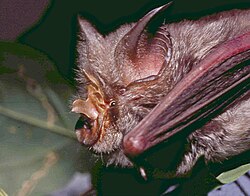 | R. fumigatus
Rüppell, 1842 | Sub-Saharan Africa
 | Size: 4–8 cm (2–3 in), plus 2–4 cm (1–2 in) tail
4–6 cm (2 in) forearm length [6]
Habitat: Forest, savanna, and caves [79] | LC
Unknown  [79] [79]
|
|---|
| Sakeji horseshoe bat | R. sakejiensis
Cotterill, 2002 | Zambia
 | Size: 4–6 cm (2 in), plus 2–4 cm (1–2 in) tail
4–6 cm (2 in) forearm length [13]
Habitat: Savanna [80] | DD
Unknown  [80] [80]
|
|---|
| Shamel's horseshoe bat | R. shameli
Tate, 1943 | Southeastern Asia
 | Size: 4–6 cm (2 in), plus 1–3 cm (0.4–1.2 in) tail
4–6 cm (2 in) forearm length [9]
Habitat: Forest and caves [81] | LC
Unknown  [81] [81]
|
|---|
| Shortridge's horseshoe bat | R. shortridgei
K. Andersen, 1918 | Eastern Asia
 | Size: 4–6 cm (2 in), plus 1–3 cm (0.4–1.2 in) tail
3–5 cm (1–2 in) forearm length [4]
Habitat: Forest [82] | DD
Unknown  [82] [82]
|
|---|
| Small rufous horseshoe bat | R. subrufus
K. Andersen, 1905 | Philippines
 | Size: 6–7 cm (2–3 in), plus 2–3 cm (1 in) tail
4–6 cm (2 in) forearm length [9]
Habitat: Forest and caves [83] | DD
Unknown  [83] [83]
|
|---|
| Smaller horseshoe bat  | R. megaphyllus
Gray, 1834 | Eastern Australia and Papua New Guinea
 | Size: 4–6 cm (2 in), plus 1–3 cm (0.4–1.2 in) tail
4–6 cm (2 in) forearm length [4]
Habitat: Caves and forest [84] | LC
Unknown  [84] [84]
|
|---|
| Smithers's horseshoe bat  | R. smithersi
Taylor, Stoffberg, Monadjem, Schoeman, Bayliss, & Cotterill, 2012 | Southern Africa | Size: 7–9 cm (3–4 in), plus 3–5 cm (1–2 in) tail
6–7 cm (2–3 in) forearm length [6]
Habitat: Savanna, shrubland, inland wetlands, and caves | NT
Unknown 
|
|---|
| Sulawesi broad-eared horseshoe bat | R. tatar
Bergmans & Rozendaal, 1982 | Sulawesi Island in Indonesia | Size: 5–7 cm (2–3 in), plus 1–3 cm (0.4–1.2 in) tail
4–6 cm (2 in) forearm length [9]
Habitat: Forest [86] | LC
Unknown  [86] [86]
|
|---|
| Sulawesi horseshoe bat  | R. celebensis
K. Andersen, 1905 | Indonesia
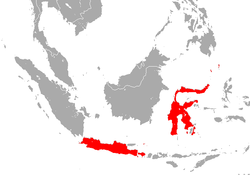 | Size: 4–6 cm (2 in), plus 1–3 cm (0.4–1.2 in) tail
3–5 cm (1–2 in) forearm length [4]
Habitat: Forest and caves [87] | LC
Unknown  [87] [87]
|
|---|
| Swinny's horseshoe bat | R. swinnyi
Gough, 1908 | Southern Africa
 | Size: 4–6 cm (2 in), plus 1–3 cm (0.4–1.2 in) tail
4–6 cm (2 in) forearm length [6]
Habitat: Forest, savanna, and caves [88] | LC
Unknown  [88] [88]
|
|---|
| Thai horseshoe bat | R. siamensis
Gyldenstolpe, 1917 | Southeastern Asia
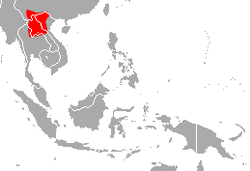 | Size: 3–4 cm (1–2 in), plus 1–3 cm (0.4–1.2 in) tail
3–5 cm (1–2 in) forearm length [13]
Habitat: Forest and caves [89] | LC
Unknown  [89] [89]
|
|---|
| Thailand horseshoe bat | R. thailandensis
Wu, Harada, & Motokawa, 2009 | Northern Thailand
 | Size: 6–8 cm (2–3 in), plus 1–3 cm (0.4–1.2 in) tail
5–7 cm (2–3 in) forearm length [11]
Habitat: Forest and caves [90] | LC
Unknown  [90] [90]
|
|---|
| Thomas's horseshoe bat  | R. thomasi
K. Andersen, 1905 | Southeastern Asia
 | Size: 4–6 cm (2 in), plus 1–3 cm (0.4–1.2 in) tail
4–6 cm (2 in) forearm length [9]
Habitat: Caves [91] | LC
Unknown  [91] [91]
|
|---|
| Timorese horseshoe bat | R. montanus
Goodwin, 1979 | East Timor
 | Size: 4–6 cm (2 in), plus 2–4 cm (1–2 in) tail
4–6 cm (2 in) forearm length [13]
Habitat: Caves and unknown [92] | EN
Unknown  [92] [92]
|
|---|
| Trefoil horseshoe bat  | R. trifoliatus
Temminck, 1834 | Southeastern Asia
 | Size: 5–7 cm (2–3 in), plus 2–4 cm (1–2 in) tail
4–6 cm (2 in) forearm length [9]
Habitat: Forest [93] | NT
Unknown  [93] [93]
|
|---|
| Wedge-sellaed horseshoe bat | R. xinanzhongguoensis
Zhou, Guillén-Servent, Lim, Eger, Wang, & Jiang, 2009 | China | Size: 5–7 cm (2–3 in), plus 3–4 cm (1–2 in) tail
4–6 cm (2 in) forearm length [13]
Habitat: Forest [94] | NT
Unknown  [94] [94]
|
|---|
| Willard's horseshoe bat | R. willardi
Peterhans & Fahr, 2013 | Democratic Republic of the Congo | Size: 6–8 cm (2–3 in), plus 2–3 cm (1 in) tail
4–6 cm (2 in) forearm length [13]
Habitat: Forest and caves [95] | EN
Unknown  [95] [95]
|
|---|
| Yaeyama little horseshoe bat | R. perditus
K. Andersen, 1918 | Yaeyama Islands in Japan | Size: 3–5 cm (1–2 in), plus 1–3 cm (0.4–1.2 in) tail
4–6 cm (2 in) forearm length [4]
Habitat: Caves, inland wetlands, and forest [96] | EN
Unknown  [96] [96]
|
|---|
| Yellow-faced horseshoe bat | R. virgo
K. Andersen, 1905 | Philippines
 | Size: 4–6 cm (2 in), plus 1–3 cm (0.4–1.2 in) tail
3–5 cm (1–2 in) forearm length [4]
Habitat: Caves and forest [97] | LC
Unknown  [97] [97]
|
|---|
| Ziama horseshoe bat | R. ziama
Fahr, Vierhaus, Hütterer, & Kock, 2002 | Western Africa
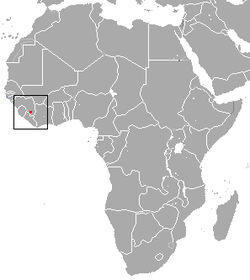 | Size: 7–8 cm (3 in), plus 3–4 cm (1–2 in) tail
about 6 cm (2 in) forearm length [13]
Habitat: Caves and forest [98] | EN
Unknown  [98] [98]
|
|---|




















































































































